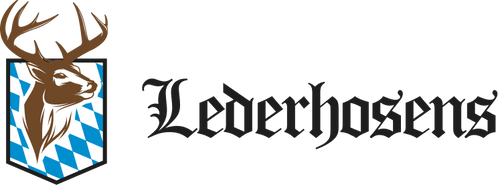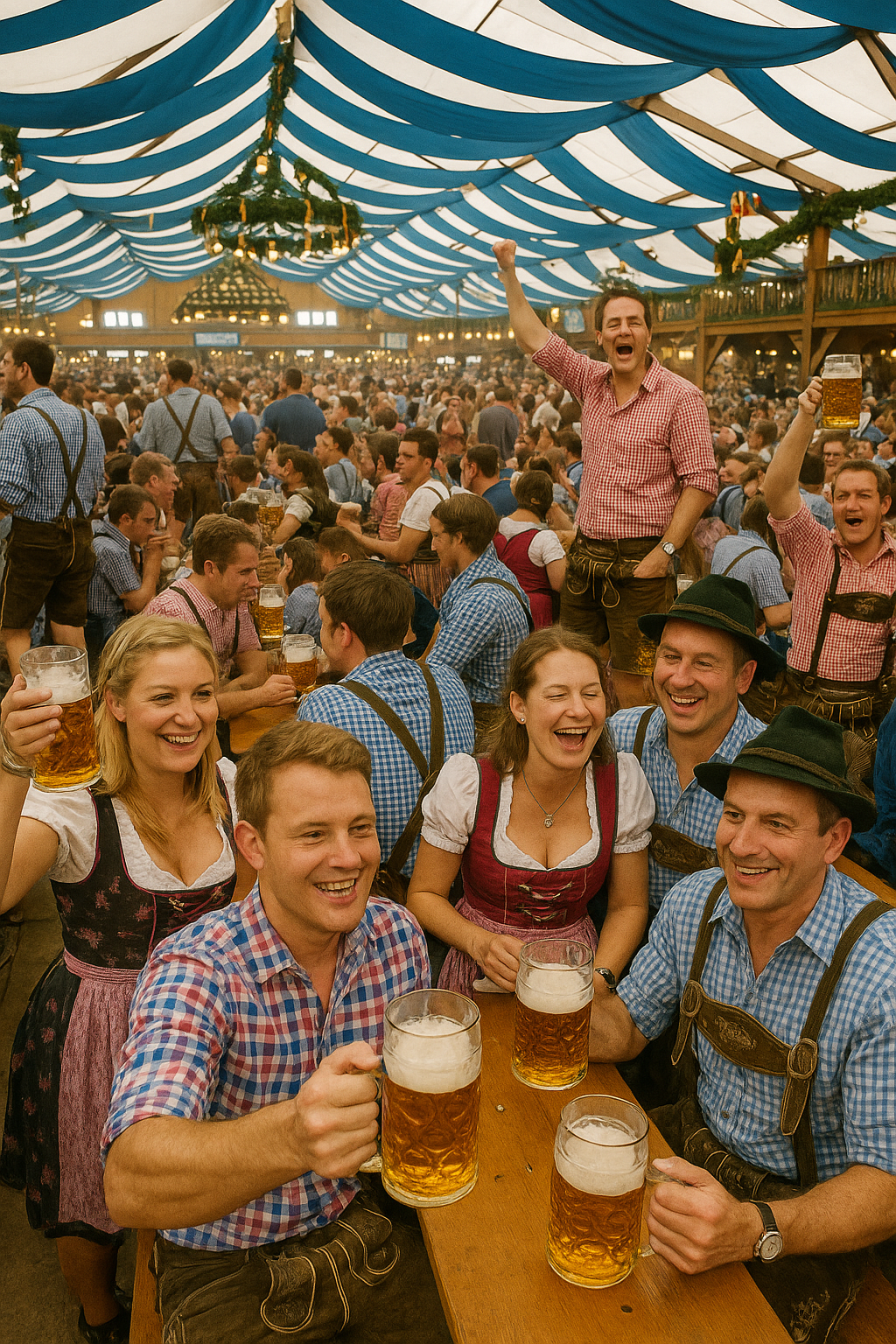There are 29 other countries that host the Oktoberfest celebration outside Munich, and America is listed at the top. These celebrations replicate the spirit of the Bavarian beerfest with their twist. All these events across the United States are smaller, with the number of visitors in the hundreds of thousands, at most. At the same time, the Oktoberfest in Munich receives 6 million visitors on average.
The world's largest Volkfest has no entrance fee, while the events held in the USA have an entrance fee. Significant differences exist between the Oktoberfest events in the USA and the OG Munich festival. Still, beer, traditional music, and relish food are present in almost every Bavarian Beerfest.
German vs. American Oktoberfest
Both festivals share the Oktoberfest name but are worlds apart in history, vibe, and scale. Let’s break it down.
Where Did The Celebration Begin?
Munich’s Oktoberfest kicked off in 1810 to celebrate Crown Prince Ludwig tying the knot with Princess Therese of Saxony-Hildburghausen. The locals loved it so much that it became a yearly tradition. It was held on a meadow called “Theresienwiese” in honor of the Princess. Fast forward 200 years, and it’s the biggest folk festival globally.
The American editions of Oktoberfests are newer. Most events starting in the 1900s were when German immigrants wanted to share their culture. Places like Cincinnati, Ohio, and Frankenmuth, Michigan, host some of the biggest events, but they’re more about celebrating German roots than recreating Munich’s version of Bavarian Beerfest.
The Turnout of Both the Oktoberfests
Munich’s Oktoberfest isn’t called the world’s largest folk fest for nothing. In 2023, about 7.2 million people packed Theresienwiese over 18 days. You’ve got locals, tourists from the U.S., Italians, Austrians—everyone’s there for the party.
U.S. Oktoberfests are cozier by comparison. Cincinnati’s Oktoberfest Zinzinnati, one of the biggest, gets maybe 700,000 to 800,000 visitors a year. Denver pulls in around 450,000. It’s lively, but nowhere near Munich’s massive crowds.
The Venues for the Celebrations
Munich’s Oktoberfest turns a 42-hectare chunk of land into a temporary party city. Starting in July, they build 38 beer tents—17 huge ones and 21 smaller ones—plus carnival rides and food stalls. The whole thing runs 16 to 18 days, from mid-September to early October, sometimes stretching to October 3 for German Unity Day.
In the U.S., Oktoberfests are less intense. Cincinnati’s Zinzinnati takes over downtown streets, not some dedicated fairground. Most American events are quick, maybe a weekend long, and use parks or city blocks. They don’t need Munich’s crazy level of setup.
The Beer Game & Strict Laws
Beer’s the star of any Oktoberfest, but Munich is strict with the rules. Only six local breweries can serve at the festival:
-
Augustiner
-
Hacker-Pschorr
-
Löwenbräu
-
Paulaner
-
Spaten
-
Hofbräu
These breweries make a special Oktoberfest brew with at least 13.5% wort and about 5.8% to 6.2 % ABV. It follows the 1516 Reinheitsgebot law, which states that the ingredients should be only water, barley, hops, and yeast. They serve it in giant one-liter Maß mugs, and in 2023, folks drank 7.4 million liters.
American Oktoberfests have no such beer rules. Local craft brewers or big names like Samuel Adams brew Märzen-style beers, but don’t stick to the purity law. Some events, like Frankenmuth, pour Munich-sourced beers like Hofbräu, but most have American brews. These American Oktoberfests serve beer in plastic cups or 16-ounce glasses, not in German Maß mugs..
The Life Size Tents vs Open Air Settings
Munich’s Oktoberfest is all about its giant marquee. There are 38 of them, 17 large ones that accommodate 12,000 people each. Every tent’s got its own vibe: Schottenhamel’s is where the mayor taps the first keg, yelling “O’zapft is!” (“It’s tapped!”) followed by 12 gunshots to commence the celebration. Hofbräu-Festzelt is a hit with International visitors for its wild music and dancing. Good luck getting in without a reservation, especially on weekends.
American Oktoberfests skip the big tents. You’ll likely find open-air beer gardens, street fairs, or park setups. Cincinnati’s event is hosted across downtown blocks with stages and food stalls. Frankenmuth has covered seating, but it’s not enclosed, like Munich’s tents. It feels more like a community block party.
Food: Traditional vs. Eclectic
In Munich, most of the menu has Bavarian classics: roast chicken (Hendl), giant pretzels (Brezn), pork knuckles (Schweinshaxe), and white sausages (Weißwurst). In 2023, visitors ate about 400,000 roast chickens. It’s all about regional ingredients and authentic flavors, though some tents have introduced vegetarian and vegan options for inclusivity.
American Oktoberfests have food options like bratwurst and sauerkraut, with the local taste.. In Fredericksburg, Texas, the state specialties like Tex-Mex fajitas are on the menu alongside the sausage. The vendors join the festival, with the food trucks serving everything from pizza to burgers.
The Crowd and Vibe of the Festival
Munich’s Oktoberfest is an international feast, but 71% of visitors are local, and the majority are Bavarians. Only 29 % are foreigners, mostly Italians, Aussies, and Americans. It’s loud, with brass bands blasting Bavarian tunes and folks in lederhosen and dirndls singing their hearts out. The tents get so full that the landlords have to shut their doors.
American Oktoberfests pull a more local crowd and feel like big county fairs. Some folks rock lederhosen or dirndls, but most keep it casual. You’ll hear polka, sure, but also rock or country bands. Places like Kitchener-Waterloo in Canada lean into community pride with parades, but it’s way calmer..
Traditions and Highlights
Munich’s Oktoberfest has some annual traditions. Opening day starts with a parade of breweries, landlords, and the Münchner Kindl mascot. At noon, the mayor taps the first keg in Schottenhamel. The first Sunday brings a huge costume parade with thousands in traditional costumes. There’s even a dedicated area on the southern part of the fairground, Oide Wiesn, celebrating nostalgic Oktoberfest.
American Oktoberfests have their peculiar segments. Cincinnati’s got a hilarious “Running of the Wieners” dachshund race. Kitchener-Waterloo does a keg-tapping nod to Munich. Parades are common but smaller, spotlighting local German heritage groups. You’ll also find kid-friendly activities like face painting, which Munich’s beer-heavy fest skips.
Price and Ease of Access
Munich’s Oktoberfest hits your wallet hard. In 2024, a Maß of beer cost about €15 ($16), and a chicken plate was €10-€15. Entry’s free, but hotels and flights to Munich cost a fortune during the fest. Scoring a tent spot often means booking months before, and that too, the whole table of 8 to 10 people.
American Oktoberfests are easier on the budget. Beers go for $5-$10, food’s under $10, and many events are free, though some charge a small fee. Finding a place to stay is simpler and cheaper, especially in smaller spots like Frankenmuth. You can just show up—no reservations needed.
Wrapping It Up!
Munich’s Oktoberfest is a bucket-list event—200 years of Bavarian tradition, insane crowds, and pure beer craze. American Oktoberfests are more laid-back, mixing German heritage with local flavor. They are easy to visit but lack the infrastructure and rich history of Munich's Oktoberfest. The celebrations held in both countries are different but bring people together to have the time of their lives.

